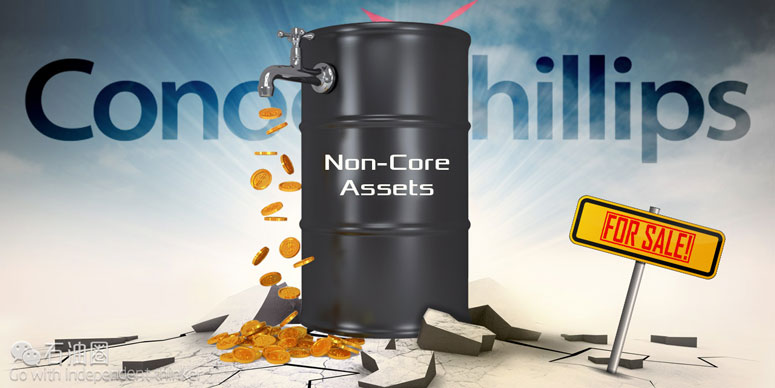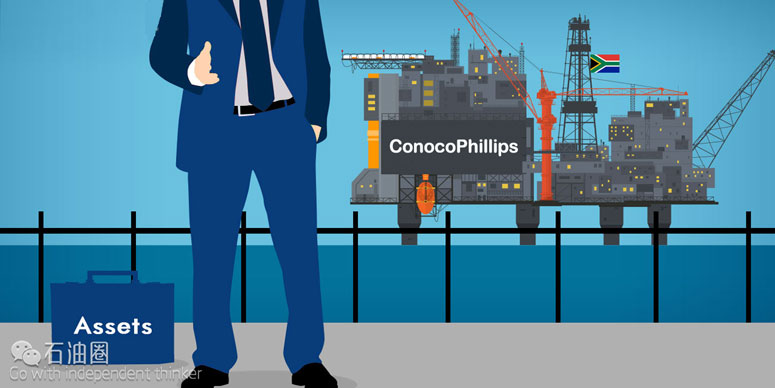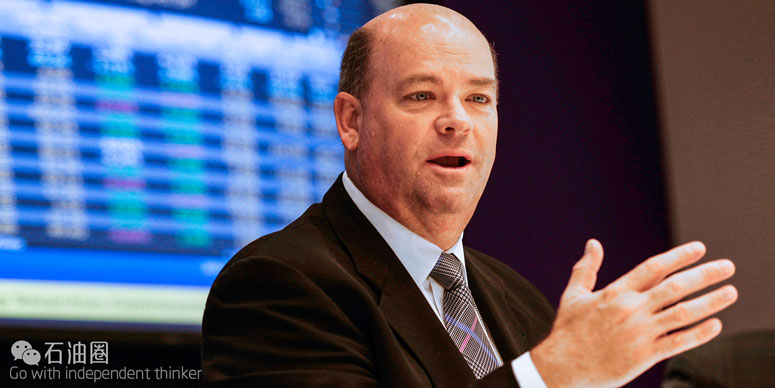NEW YORK (Bloomberg Gadfly) — ConocoPhillips probably doesn’t see it this way, but a good starting point for its analyst jamboree on Thursday came earlier this month, courtesy of Royal Dutch Shell Plc’s earnings call. This was Shell’s CFO:
Oil, we’ve long been of the opinion that demand will peak before supply. And that peak may be somewhere between 5 and 15 years hence …
Peak oil demand perhaps as soon as 2021? No wonder Shell’s pushing a natural-gas story. But Conoco has a compelling narrative of its own for oil’s possible pre-end days.
This isn’t about shifting to more gas. The exact opposite, in fact: Conoco plans to sell up to $8 billion worth of North American gas assets, taking gas down to less than a tenth of projected production. The real story involves that $8 billion and what Conoco intends to do with its cash in general. Here’s the headline, delivered upfront on Thursday morning by CEO Ryan Lance:
You can’t count on rising commodity prices to bail out your business model.
That ought to be printed above the door of every oil company’s headquarters. It isn’t quite as apocalyptic as saying oil demand will peak in the 2020s. But Conoco’s scenarios recognize that possibility and, above all, prioritize paying off debt and pushing cash to shareholders before any investment for growth.
In an industry that tends to promise ever-increasing production and/or dividends, Conoco’s is a bit more honest, given the volatility of the cycle.
Conoco’s plan is centered on a capital expenditure budget to maintain flat production of about $4.5 to $5 billion a year, dividends of $1.2 billion, authority to buy back $3 billion of shares and a target of cutting debt by $7 billion by 2019.
Consensus forecasts compiled by Bloomberg imply operating cash flow of $21.6 billion across 2017 and 2018. Take out $10 billion of capex and assume Conoco uses all that buyback capacity over the next two years. On that basis, it could comfortably raise its dividend by 10% each year and still generate excess cash of $5.8 billion by the end of 2018.
And that’s in part because buying back shares offsets some of the cost of raising the dividend (while also boosting production on a per-share basis). Throw in $5 billion of disposal proceeds—the bottom end of the target—and Conoco would exit 2018 with about $10.8 billion of excess cash; enough to cut its debt and invest for further growth. Meanwhile, it would have delivered on its target of paying out between 20% and 30% of operating cash flow to investors.
Like most company targets, it reads a little halcyonic. The key here, though, is that capex figure and the portfolio backing it.
When Conoco split off its downstream arm Phillips 66 in 2012, it had eight megaprojects on the go. As I’ve discussed previously, megaprojects’ long timescales and individual nature (which limits economies of scale) make them especially risky in an environment of volatile energy prices. That’s why the industry embarked on so many of them when oil was coasting along at $100/bbl and then, Conoco included, saw their free cash flow and returns drop off a cliff when the cycle turned south.
Conoco’s new strategy reflects some penitence for earlier excesses. The megaprojects, liquefied natural gas and oil sands, are now largely done and will provide a steady base of supply for capex of just $500 million a year. The key to Conoco making the strategy work will be its ability to manage decline in its conventional assets in places like the North Sea and, especially, its unconventional fields in places like the Eagle Ford and Permian basin.
Conoco claims it can make all this work with oil prices below $50/bbl. All the major oil companies are slashing their break-even targets, albeit not to this degree. One thing lending credence to Conoco’s is its careful explanation of fully loaded costs for each barrel, including things like corporate overhead—something the rest of the industry doesn’t always present clearly. Indeed, given that most of the sector’s presentations offer a mix of complex maps, photos of rigs and fuzzy bar charts with no numbers, Thursday’s deck from Conoco was a rare example of relative transparency.
Having seen its earlier strategy collapse with February’s ignominious dividend cut, a more-open approach was warranted. Focusing on lower-cost barrels offers the best hedge against excess supply or even peak demand, as well as the chance of windfalls when prices turn up. Conoco’s message isn’t a bullish one for the energy industry as a whole. That’s why it’s the right one.
ConocoPhillips to sell up to $8 billion of North American gas assets
NEW YORK — ConocoPhillips is to initiate a $5-billion to $8-billion divestiture program, which will focus primarily on North American natural gas, as the company seeks to bolster its operations.
The sale was among a number of measures, which include a 4% cut to next year’s capital budget and a $3-billion share repurchase program, aimed at boosting the company’s “value proposition.”
“During the past two years, we have significantly transformed ConocoPhillips to succeed in a lower, more volatile price environment. We’ve lowered the capital intensity and break-even price of the company, lowered the cost of supply of our investment portfolio, and created strategic flexibility for future price cycles,” Ryan Lance, the company’s chairman and CEO, said Thursday. “We believe our plan offers a differentiated strategy within the E&P sector that is focused on free cash flow generation and improving returns to shareholders.”
“The acceleration actions we’ve announced today will allow us to achieve our value proposition priorities at Brent prices of about $50/bbl,” added Lance. “These priorities include a debt target of $20 billion, a 20% to 30% payout of operating cash flows to shareholders, and modest production growth to drive margin and cash flow expansion. In setting out these priorities, our goal is to have strong resilience to low commodity prices with the ability to capture upside during periods of higher prices.”
The company’s 2017 operating plan includes capital expenditures guidance of $5 billion, a decrease of 4% compared with 2016 guidance of $5.2 billion and more than 50% lower than 2015 capital expenditures and investments of $10.1 billion. Spending in 2017 will focus primarily on flexible unconventional development programs in the Lower 48, conventional projects in Europe, Asia Pacific and Alaska, and base asset maintenance. Approximately $0.6 billion is included for exploration, which is primarily focused on unconventionals, appraisal of the Barossa discovery, and the closeout of deepwater Gulf of Mexico and Nova Scotia drilling obligations.
Full-year 2017 production is expected to be 1.540 MMboed to 1.570 MMboed, which results in flat to 2% growth compared with expected full-year 2016 production of approximately 1.540 MMboed when adjusted for 2016 expected dispositions. Growth is expected to come primarily from ramp up at APLNG in Australia, Surmont 2 in Canada and Kebabangan in Malaysia, as well as increased activity in the Lower 48 unconventionals, partly offset by normal field decline. The company’s production outlook excludes Libya.
The company continues to achieve cost reductions across the business. Guidance for 2017 production and operating expenses is approximately $5.2 billion, which results in adjusted operating cost guidance of $6 billion, a 9% improvement compared with 2016 adjusted operating cost guidance.
“We believe our company offers one of the most unique value propositions in the E&P sector,” said Lance. “We’ve reset virtually every aspect of the business—our capital program, our cost structure and our portfolio—during the recent industry downturn. Now, we’re in a differential position to generate free cash flow as prices recover and we implement our clear priorities for allocating available cash. In a future of volatile prices, we can demonstrate that our disciplined, returns-focused approach will deliver strong performance for all our stakeholders.”


 石油圈
石油圈



